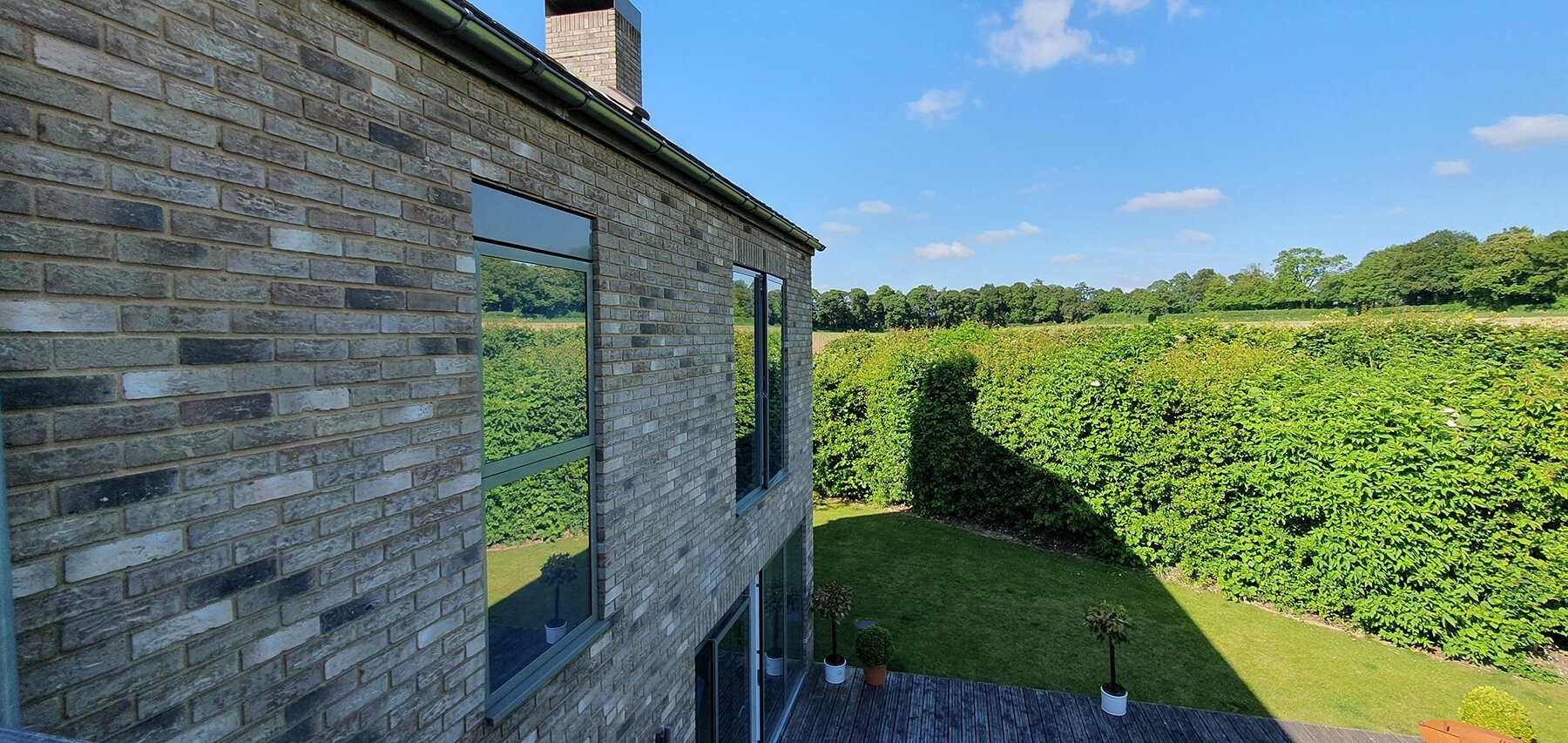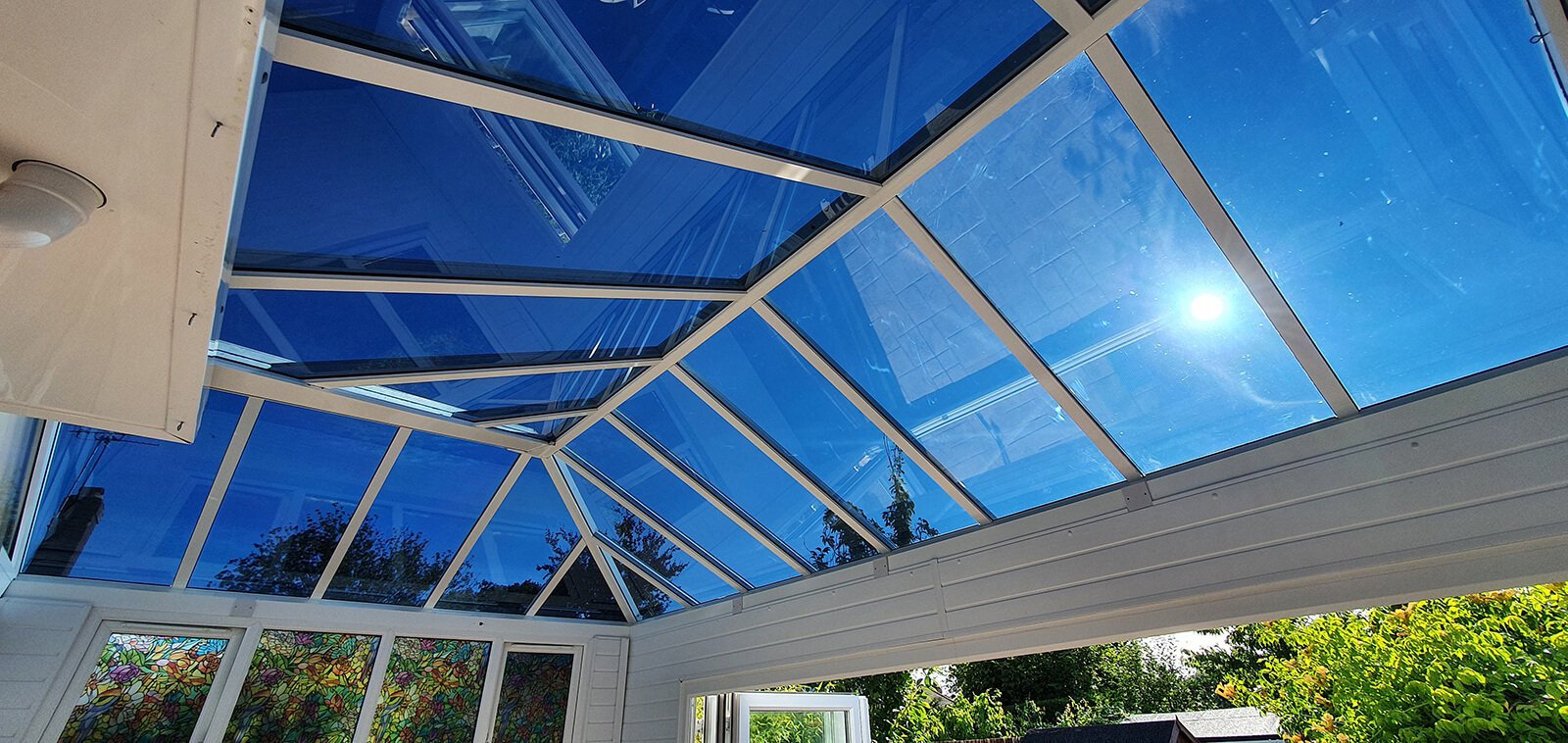
Solar Film for Home Windows
Heat & Glare are two of the most common problems solved by the installation of a solar control window film.
It’s quick, clean and you will immediately feel the benefits.
Window film offers an effective and immediate solution
Window film is a self adhesive material which is applied directly to glass. It works by rejecting and filtering solar energy from the sun. There are many window film choices with varying properties. The most effective window films at heat rejection are the most reflective and also the darkest. Before you run away worried about how dark your home will be, fear not! There’s no point installing the most effective film and looking through dark windows on a gloomy day in mid winter - this can become quite oppressive. Our range of window films are specifically developed for homes. This ensures an effective heat reduction solution without compromising too much on natural light.
Heat Rejection Window Films
Heat rejection window film works to block heat from the sun as it enters through glass windows and doors. The most effective at heat rejection is a highly reflective or mirrored window film. Technology advances now mean it is possible to apply a near clear window film and still achieve good heat rejection results. For maximum heat rejection it is necessary to have some form of reflective nature to the film, that doesn’t mean it needs to be a mirror finish but the best at heat rejection will have a reflective character to it. Glass by nature has a reflective surface and we have films which maintain a similar appearance to that of clean glass on a bright day. There are virtually clear IR (infra red) filtering films which offer heat rejection but these are most suited to single glazed windows typically found in shop front windows where clear vision is essential.
Anti Glare Window Films
Say goodbye to eye strain and fatigue with anti glare window film.
To reduce glare with window film we need to cut down the amount of visible light entering a room. Think dark sunglasses on a sunny day! Darker glasses are going to give much better relief to straining eyes than a light tint. The same is true in your home. The darker the film the greater the glare reduction. Anti glare window film is used to improve aesthetics of a room, creating a pleasing balanced light. It’s also used reduce glare on screens such as TV’s, computers and tablets.
We can guide you though the choice of films and the benefits of each.
UV Filtering Window Film
All of our window films filter a minimum of 99% UV (ultra violet) light. This ensures your home furnishings, collectables and family are kept safe from the damaging effects of UV light.
Solar control window film FAQs
-
Any level of tint will improve the comfort within your home. If you need an anti glare window film to make viewing screens possible in bright light you need to be reducing the visible light by around 80%. If it’s just to enhance comfort in an environment a 50% to 60% reduction will offer good results. A 100% glare reduction is possible if you choose a blackout window film.
-
This all depends on the amount of visible light reduction. The good news is we have a wide range of window films offering varying degrees of glare reduction. We will guide you through the process and recommend the most appropriate solution.
-
This depends on the window film choice. We have very reflective window films and also non reflective neutral finishes depending on your preference.
Heat rejection window film types
DR or Dual reflective window films
These have a reflective side which faces away from the buidling and a netural internal face. The advantage of a dual reflective film over a standard silver reflective film is that it has a neutral internal finish which limits internal reflections in bright rooms and also at night time when the lights are on inside a room.
Silver reflective window films
Exactly as it says, this is a reflective metalised window film. Silver reflective films offer the most effective heat rejection and do have place in the range. However we do not usually recommend darker films below 50% light transmission in homes. The internal reflections at night time and also during the day in rooms which lots of natural light coming from multiple directions (such as conservatories or large roof lights combined with bi-fold doors). The most common and readily available window film is a silver reflective 20, it has very good heat rejection properties but we do not usually recommend this for the reasons above. A silver 50 is a much better choice for side windows of a home because it is a lighter film the reflective appearance is far less. It gives similar performance to that of a darker neutral finish window film.
Neutral or low mirror window films
A neutral and often referred to as a low mirror window film will give good all round results. This offers a good balance of heat rejection and an aesthetics giving a pleasing tinted finish to the glass without too much reflection.
The window films available are LM20, LM35, LM50.
Low-e window films
Designed to offer heat rejection along with reducing heat loss in colder months. These films are most effective when used on single glazing.
External window films
Window films can also be applied externally for even greater heat rejection gains. This is especially the case with double glazed windows. External window films are designed for external installation and feature an additional protective coating to ensure longevity. External window films will not last as long as an internal option but you can expect 3 to 5 years from most choices with some offering up to 10 years warranty.
Window films applied to double glazing
Double glazed windows are the most common type found in homes in the UK. These are two panes of glass separated by an air gap. Window film is easily applied to double glazed windows internal and externally. When applied internally the film
Window films applied to triple glazing
Solar control window films are typically not suitable for an internal installation on triple glazing. There are some window films which can be applied internally such as clear UV filtering or some privacy window films. Many solar control films can be applied externally but it’s always best to get in touch so we can perform a glass analysis and compatibility survey on your windows.
Window films applied to single glazing
Window films applied internally to single glazing offer great performance figures and are easily applied. Many window film test calculations are performed on single glazing. When comparing window film specifications ensure the figures given are applicable to your glass type.
Window films applied to secondary glazing
Window film can be applied to secondary glazing subject to compatibility tests. Secondary glazing will either be glass or clear acrylic. There are films for each of these types and it’s important to ensure the correct window film is specified. We will of course help guide you to best choice for your windows.
Ready to discuss window film for your home?




